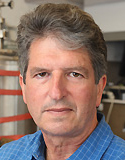
| Home | About Us | Contribute | Bookstore | Advertising | Subscribe for Free NOW! |
| News Archive | Features | Events | Recruitment | Directory |
| FREE subscription |
| Subscribe for free to receive each issue of Semiconductor Today magazine and weekly news brief. |
News
26 August 2009
Concentrator combination sets solar efficiency record of 43%
Researchers in Australia have set a world record for photovoltaic conversion efficiency, thanks largely to a new, high-efficiency silicon cell operating in the near-infrared range of the spectrum.
 Professor Martin Green and Anita Ho-Baillie from the University of New South Wales (UNSW) used five different cells and spectrum-splitting optics to reach an experimental efficiency of 43% - measured under the global ASTM G173-03 spectrum, a terrestrial standard. Earlier this year, a US team put together a similar system operating at 42.7% efficiency.
Professor Martin Green and Anita Ho-Baillie from the University of New South Wales (UNSW) used five different cells and spectrum-splitting optics to reach an experimental efficiency of 43% - measured under the global ASTM G173-03 spectrum, a terrestrial standard. Earlier this year, a US team put together a similar system operating at 42.7% efficiency.
Picture: UNSW's professor Martin Green.
Instead of using multi-junction cells that typically feature in today’s state-of-the-art concentrator photovoltaic (CPV) systems, Green and Ho-Baillie have returned to an earlier method, in which the solar spectrum is split and steered towards individual, unstacked cells.
Although this can make a CPV system more optically complex than those featuring multi-junction cells, it does mean that more of the solar spectrum can be converted into electricity, without the need for a single, but highly complex, semiconductor stack.
As a result, the Australian team was able to use five different cells for solar conversion.
“The greater flexibility in cell choice made possible with the spectrum-splitting approach, combined with the low losses associated with dichroic reflectors, makes it likely that higher efficiency will always be possible than with the monolithic approach,” suggests the team. Their paper describing the latest work is due to be published in September in the journal Progress in Photovoltaics.
The five cells used in the new system include four based on compound semiconductor alloys - component maker Emcore and the US National Renewable Energy Laboratory (NREL) supplied the GaInP/GaAs and GaInAsP/GaInAs cells used in the experimental setup. But the main improvement on the previous record results from a silicon cell designed at UNSW and operating in the 890-1100nm region.
Although the 43% conversion figure is undoubtedly higher than what any such cell arrangement would be able to deliver in a terrestrial CPV system, Green believes that any optical losses would be similar in magnitude to those seen with the more conventional stacked-cell approach.
Stuart Wenham, who is the director of the Australian Research Council’s PV Center of Excellence at UNSW, believes that the work indicates the future potential of solar photovoltaic power. “This latest record involves an expensive combination of cells and the sunlight was focused to produce a much higher intensity than standard sunlight for these measurements,” he said. “[But] it does show what may eventually be practical.”
![]() Search: PV silicon cell
Search: PV silicon cell
Visit: www.pv.unsw.edu.au
The author Michael Hatcher is a freelance journalist based in Bristol, UK.